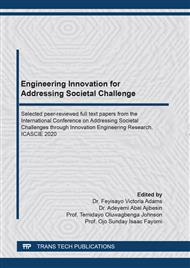[1]
V. Kattsov, V. Govorkova, V. Meleshko, T. Pavlova, I. Shkolnik, Climate change projections and impacts in Russian Federation and central Asia states, North Eurasia Climate Centre, Saint Petersburg, (2008).
Google Scholar
[2]
M.A. Adegboye, W.-K. Fung, A. Karnik, Recent Advances in Pipeline Monitoring and Oil Leakage Detection Technologies: Principles and Approaches, Sensors. 19 (2019) 2548.
DOI: 10.3390/s19112548
Google Scholar
[3]
H. Dong, J. Zhao, W.Q. Zhao, M.L. Si, J.Y. Liu, Study on the thermal characteristics of crude oil pipeline during its consecutive process from shutdown to restart, Case Stud. Therm. Eng. 14 (2019) 100434.
DOI: 10.1016/j.csite.2019.100434
Google Scholar
[4]
B. Yu, C. Li, Z. Zhang, X. Liu, J. Zhang, J. Wei, S. Sun, J. Huang, Numerical simulation of a buried hot crude oil pipeline under normal operation, Appl. Therm. Eng. 30 (2008) 2670-2679.
DOI: 10.1016/j.applthermaleng.2010.07.016
Google Scholar
[5]
X.G. Cui, J.J. Zhang, Determination of the thermal influence zone of buried hot oil pipeline on steady operation, J. Univ. Pet. (2004) 75-78.
Google Scholar
[6]
C. Xu, B. Yu, Z. Zhang, J. Zhang, J. Wei, S. Sun, Numerical simulation of a buried hot crude oil pipeline during shutdown, Pet. Sci. 7 (2010) 73-82.
DOI: 10.1007/s12182-010-0008-x
Google Scholar
[7]
C.J. Arthur, L. Russell, P. Adames, An investigation of buried pipe outer heat transfer coefficient correlations, BHR Group, Banff, (2016).
Google Scholar
[8]
V.V. Golik, Y.D. Zemenkov, A.A. Gladenko, Seroshtanov I.V., Modeling the heat transfer processes in the pipe-soil system, IOP Conference Series: Materials Science and Engineering. 663 (2019) 012012.
DOI: 10.1088/1757-899x/663/1/012012
Google Scholar
[9]
B. Moiseev, Y. Zemenkov, N. Nalobin, S. Dudin, Thermal calculations of underground oil pipelines, MATEC Web of Conferences. 106 (2017) 06005.
DOI: 10.1051/matecconf/201710606005
Google Scholar
[10]
F. Sund, A. Oosterkamp, S.M. Hope, Pipeline Modeling – Impact of Ambient Temperature and Heat Transfer Modeling, International Society of Offshore and Polar Engineers. (2015) 304-309.
Google Scholar
[11]
A. Fakroun, H. Benkreira, Rheology of waxy crude oils in relation to restart of gelled pipelines, Chem. Eng. Sci. 211 (2020) 115212.
DOI: 10.1016/j.ces.2019.115212
Google Scholar
[12]
A.V. Chernikin, Generalization of the coefficient of hydraulic resistance of pipelines, Science and technology of hydrocarbons. 1 (1998) 21–23.
Google Scholar
[13]
A. Kadyirov, J. Karaeva, Ultrasonic and Heat Treatment of Crude Oils, Energies. 12 (2019), 3084.
DOI: 10.3390/en12163084
Google Scholar


